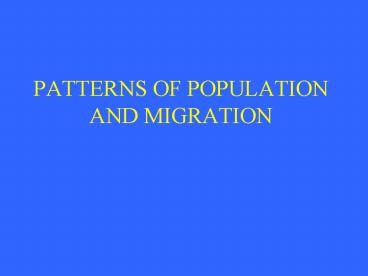PATTERNS OF POPULATION AND MIGRATION - PowerPoint PPT Presentation
1 / 29
Title:
PATTERNS OF POPULATION AND MIGRATION
Description:
... urban decentralization, urban sprawl, gentrification ... Gentrification (central city) Racial and ethnic clustering and segregation ... Gentrification ... – PowerPoint PPT presentation
Number of Views:111
Avg rating:3.0/5.0
Title: PATTERNS OF POPULATION AND MIGRATION
1
PATTERNS OF POPULATION AND MIGRATION
2
(No Transcript)
3
(No Transcript)
4
- Pre-1820 - United Kingdom, Northern Europe, and
Africa - 1820 1890 Northern and Western Europe (United
Kingdom, Ireland, Germany) - 1890 1925 Southern and Eastern Europe
- 1925 1965 Immigration restrictions
- 1965 present Latin America and Asia
5
- 1960s present most to 6 states (California,
Texas, New York, Florida, Illinois and New
Jersey) 70 of immigrants live in these states - In 2000, 33 of foreign born lived in New York
and Los Angeles metropolitan areas - What about non-traditional destinations such as
Atlanta?
6
Atlanta Immigration
- Before 1980 primarily domestic migration
- After 1980 both domestic and international
migration - Pace of immigration increased since 1990
- Coincides with Atlantas emergence as a
high-technology metropolitan area - Foreign-born account for 26 of metro Atlantas
population increase from 1990 - 2000
7
Atlanta Immigration, cont.
- 3/5 of all foreign-born in metro Atlanta arrived
after 1990 - ½ from Latin America, ¼ from Asia (mirrors
national trends) - 28 of foreign born from Mexico (mirrors national
trends)
8
Top 10 countries of origin of foreign born U.S.
and metro Atlanta
9
Urban Geography
- study of spatial patterns and processes
associated with urban areas - Systems of cities cities as points in space and
their interrelationships examples urban
hierarchies, trade patterns - Internal structures of cities spatial
arrangement of places and activities within urban
areas - examples urban decentralization, urban
sprawl, gentrification
10
Urban decentralization
- Metropolitan areas sprawl in all directions
- Suburbs take on many characteristics of
traditional downtowns - Characteristic of North American (especially
U.S.) cities
11
Models of the internal structure of the city
- Abstractions identify basic elements of urban
structure - Early 20th century the concentric ring model
- Late 20th century the urban realms model
12
Concentric zone model
- Urban land uses neatly organized in rings around
a CBD (central business district) - Assumptions CBD most accessible part of the
city, higher income people value land more than
accessibility - Incomes rise with distance away from CBD
13
(No Transcript)
14
(No Transcript)
15
Urban Realms Model
- City consists of several realms
- CBD is only one of several activity centers
- Edge cities develop in suburban areas and have
many functions traditionally associated with
downtowns - Assumptions freeways and dominance of autos,
accessibility is more diffuse
16
(No Transcript)
17
(No Transcript)
18
Internal Structure of Contemporary Cities
- Gentrification (central city)
- Racial and ethnic clustering and segregation
- Urban Sprawl (outer areas)
19
Gentrification
- The process of urban revitalization in which
higher income residents displace lower income
residents in central city neighborhoods
20
(No Transcript)
21
(No Transcript)
22
(No Transcript)
23
(No Transcript)
24
(No Transcript)
25
Urban sprawl
- A low-density, fragmented, and auto-dependent
form of urban development
26
(No Transcript)
27
(No Transcript)
28
(No Transcript)
29
(No Transcript)































